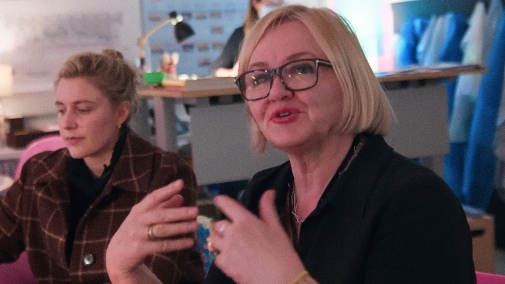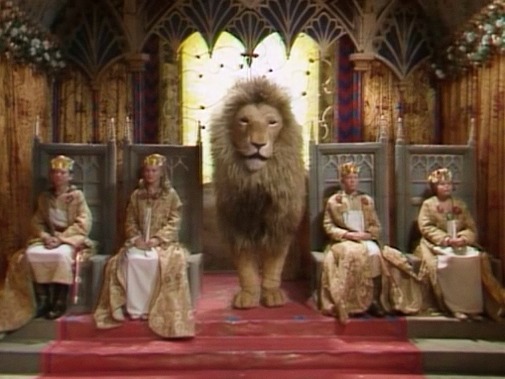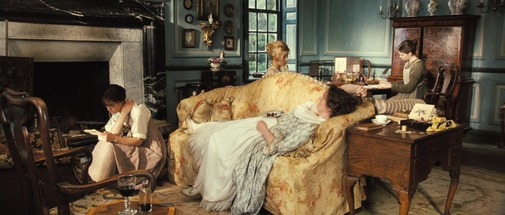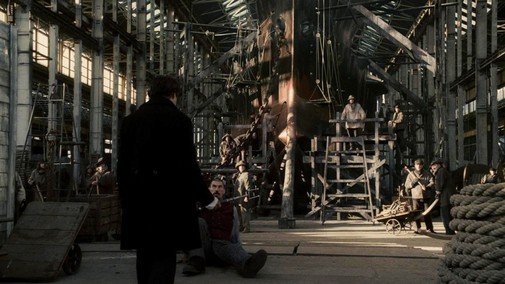Sarah Greenwood: From Narnia to Barbieland
 Sunday, March 17, 2024 at 8:00PM
Sunday, March 17, 2024 at 8:00PM  Gerwig and Greenwood discuss BARBIE in a behind-the-scenes video. | © Warner Bros.Last Sunday, Sarah Greenwood officially became the most nominated production designer without an Oscar, breaking her tie with Nathan Crowley for the "Diane Warren" distinction. This year, she was nominated for Barbie, another triumph among many in a career spanning 1980s BBC miniseries to 21st-century Hollywood blockbusters.
Gerwig and Greenwood discuss BARBIE in a behind-the-scenes video. | © Warner Bros.Last Sunday, Sarah Greenwood officially became the most nominated production designer without an Oscar, breaking her tie with Nathan Crowley for the "Diane Warren" distinction. This year, she was nominated for Barbie, another triumph among many in a career spanning 1980s BBC miniseries to 21st-century Hollywood blockbusters.
Though many of her best works rely on a sense of material realism, the Greta Gerwig feature aimed for a sort of "authentic artificiality" where denying reality is a sort of reality into itself. For Greenwood, midcentury Palm Springs was a source of real-world inspiration to combine with Mattel's history, adding a sense of internal logic to Barbieland. Moreover, the aesthetic was sustained by old-school techniques like hand-painted backdrops and a practical fake sea, visible wires holding everything together in the loopy transitions between worlds. She used scale as a tool for wonderment, took cues from Gene Kelly musicals, and delivered a screen dream in fifty shades of fuchsia. Indeed, her team used so much pink paint that they caused an international shortage…
Like many British filmmakers, Sarah Greenwood started her career on stage. After attending the Wimbledon School of Art, she won the UK Arts Council bursary and worked for three years in theater. At the end of this period, Greenwood set her sights on the BBC, wishing to have more creative challenges and a steadier source of income. She earned a position within their prestigious art department as a design assistant. In this new home, she was involved in many projects that demanded a reconsideration of the basics. First, there was a greater plurality of spaces than in theater. Second, the camera wanders within those sets, freer than a theater audience can ever be within a classical model.
 TH E LION, THE WITCH AND THE WARDROBE (1988) Marilyn Fox
TH E LION, THE WITCH AND THE WARDROBE (1988) Marilyn Fox
It should be noted that Greenwood didn't start immediately working on the sort of narrative project that would later define her career. During this learning phase of her transition from stage to screen, she began designing for programs like Late Show and Later with Jools Holland. Only after some time did she enter the cosmos of BBC Drama. The Chronicles of Narnia was her first significant endeavor, extending for three years and three different miniseries adaptations that combined historical and fantasy sets, faked outdoors, and whatnot. Then, there were more straightforward period dramas like The Tenant of Wildfell Hall and The Moonstone.
As the BBC Drama department started to crumble in the late 90s, Greenwood got her foot in their more cinematic productions like The Governess but soon found herself unmoored and without a safety net. By the dawn of the 21st century, she was a freelancer with a loyal artistic partner in set decorator Katie Spencer. Another essential creative collaboration came in the form of Joe Wright, then a bright young novice who'd won a short film BAFTA and was eager to expand his horizons. They got along swimmingly, both besotted by the possibilities of TV and film as collaborative melting pots of creativity. The miniseries Nature Boy was the first of many projects they shared – Greenwood has designed nearly all of Wright's works since.
Despite its stylistic strides into romanticism, Nature Boy isn't a good indicator of what the director-designer duo would become famous for achieving. In that regard, Charles II: The Power & the Passion, also known as The Last King, is a better example. That production's success laid the path for Wright's big-screen feature debut and one of the best Jane Austen adaptations ever made. Between these projects, one can see how Greenwood has worked extensively in historical buildings. She even recreated the same real-life places for studio shooting multiple times. Think of how she has represented the British Parliament from the Restoration to the present day.
 CHARLES II: THE POWER & THE PASSION (2003) Joe Wright
CHARLES II: THE POWER & THE PASSION (2003) Joe Wright
For Pride & Prejudice, since they couldn't work directly on some houses' walls, her team constructed new rooms inside the existing ones, the underlying historical building a basic structure rather than the final on-screen set. In Atonement, they took over Tyntesfield like a blank canvas, turning the opulent space into a 360 degrees piece of scenography with visual leitmotiv like pops of green in arsenic rhyme with Jacqueline Durran's famous dress for Keira Knightley. One should understand that the job of a production designer isn't always to build sets from the ground up. Many times, adapting ideas to a location and then adapting the real place to a story's dramaturgical demands can be equally important.
Hanna is the perfect example of this, mixing the fantasy of a cabin in the woods with the actual office buildings, brutalist architecture, and the Spreepark in East Berlin. The Grimm House already existed, but there's a great deal of work in shaping it to the script's specificities, the project's overall aesthetic of a contemporary fairytale with blood smeared all over. Then again, sometimes, one has the resources and the dramatic foundation to justify creating an entire world from scratch. Such was the case of Guy Ritchie's Sherlock Holmes movies, lavish big-budget productions aided by CGI extensions, Eva Kuntz's illustrations, and massive studio shoots. Greenwood got to experiment with an industrialist aesthetic and even bring to life the Tower Bridge mid-construction, working from 19th-century documentation to get every detail right.
And then, there's Anna Karenina, Joe Wright's radical re-imagining of Tolstoy's literary classic. Director and designer took over the C stage at Shepperton Studios and created a derelict Russian theater within which every movement of the drama takes place. It's a complete repudiation of naturalism, embracing the artifice of theater craft as a reflection of the aristocracy's social performance. The camera swirls, and spaces transform within single shots. Codified sections of the building work along Shakespearean rules, with each area of the theater embodying a specific real-world counterpart. When a particular scene took the team to an actual location – the train, for example – it was Greenwood's job to eradicate reality, enclosing it within the theatrical fakery.
If I had my way, Greenwood and Spencer would have won the Oscar for Anna Karenina, but that wasn't in the cards for AMPAS. Still, life goes on, and in 2017, the team received its fifth and sixth nominations. Yes, they got the rare double-dipping honor thanks to Disney's remake of Beauty and the Beast and Joe Wright's foray into biopic cinema, Darkest Hour. The sheer contrast between the Rococo excess of one film and the underground stateliness of the other might have been enough to secure the distinction. And yet, it was another loss for Greenwood and Spencer. Afterward came Wright's Cyrano, a watercolor rendition of the classic play turned musical, full of inventive design and painterly winter warfare that puts Scott's Napoleon to shame.
 PRINCESS & PEPPERNOSE (2021) Joe Wright
PRINCESS & PEPPERNOSE (2021) Joe Wright
Her flexibility is incredible, encompassing Art Déco extravaganza and gritty realism, the curated aesthetics of intelectual chic in something like Starting for 10 and the opulence of her Wright works. There's nothing she can't do, though strict sci-fi is still unexplored. As far as her recent filmography is concerned, Wright's Princess & Peppernose short and Barbie are Greenwood's latest credits. She also worked in the upcoming Amy Winehouse biopic Back to Black, which is already scheduled for a 2024 release.
Despite the differences in projects, some parts of the process are constant. According to Greenwood, production design is a broad discipline for which numerous approaches are valid. There is no set right or wrong way to do things, and one must be open to adaptation, to be a sponge within a collaborative effort. However, there is an imperative of self-belief, an artistic courage to assert your conviction and bring a vision to the screen. It can be contemporary, period or fantasy, character-based or more presentational, but the creative demands remain the same. She doesn't draft, but one can be a genius production designer without drawing skills, for there's much more to consider, like how characterizations can be expressed in living spaces or how a film's aesthetic connects to its backbone concepts. Her work speaks for itself – brilliant and breathtaking in every regard.
THE ABDUCTION CLUB (2002) Stefan Schwartz
The Abduction Club is available to rent and purchase on Apple TV.
PRIDE & PREJUDICE (2005) Joe Wright
Pride & Prejudice is streaming on Peacock Premium. You can also find it on most major platforms where it's available for renting or purchase.
STARTER FOR 10 (2006) Tom Vaughan
Starter for 10 is streaming on Max. It is also available on Amazon, Apple TV, Google Play, YouTube, and VUDU.
ATONEMENT (2007) Joe Wright
Atonement is streaming on Peacock Premium. You can also rent and buy it on most major platforms.
MISS PETTIGREW LIVES FOR A DAY (2008) Bharat Nalluri
Miss Pettigrew Lives for a Day is available to rent and purchase on Amazon, Apple TV, Google Play, YouTube, and VUDU.

SHERLOCK HOLMES (2009) Guy Ritchie
Sherlock Holmes is available to rent and purchase on Amazon, Apple TV, Google Play, YouTube, VUDU, and the Microsoft Store.
HANNA (2011) Joe Wright
Hanna is streaming on Peacock Premium. You can also rent and purchase it on most major PVOD platforms.
SHERLOCK HOLMES: A GAME OF SHADOWS (2011) Guy Ritchie
Sherlock Holmes: A Game of Shadows is available to rent and purchase on Amazon, Apple TV, Google Play, YouTube, VUDU, the Microsoft Store, and Spectrum On Demand.
ANNA KARENINA (2012) Joe Wright
Anna Karenina is available to rent and purchase on Amazon, Apple TV, Google Play, YouTube, VUDU, and the Microsoft Store.

BEAUTY AND THE BEAST (2017) Bill Condon
Beauty and the Beast is streaming on Disney+. You can also rent and purchase it on most major platforms.
DARKEST HOUR (2017) Joe Wright
Darkest Hour is streaming on Netflix, but it can also be rented or purchased on most major platforms.
REBECCA (2020) Ben Wheatley
Rebecca is streaming exclusively on Netflix.
CYRANO (2021) Joe Wright
Cyrano is streaming on Amazon Prime Video, FuboTV, and MGM+. You can also rent and purchase it on most major platforms.

BARBIE (2023) Greta Gerwig
Barbie is streaming on Max. You can also rent and purchase it on most of the major platforms.
Should Sarah Greenwood already have an Oscar? If so, what film should have won her the gold?








































































Reader Comments (10)
The anecdote about the pink paint shortage *would* land with audiences who don’t understand the scale of the global economy—or the fact that the Barbie movie probably accounted for less than 1% of 1% of all pink paint used in its year. It’s a silly exaggeration that only an artist could make.
But this is Gerwig’s Barbie, it can’t simply be “lots of pink paint,” it must be a “global shortage inducing volume of pink paint.” We will look back at the hyperbole of the Barbie phenomenon and laugh.
DK -- I shortened the anecdote for brevity, but I believe her. In interviews, Greenwood specifically mentioned it was one shade of fluorescent pink paint from the brand Rosco. The international shortage was for that particular product.
She should've gotten it for Barbie. Easily.
Barbie is an eyesore. Should have won for Anna Karenina.
Anna Karenina is the obvious answer, except that Lincoln won that year and Lincoln's production design was A+ so I'm not eager to take away its prize, so ...
I'm glad you mentioned Hanna. I think I'd go with its hard fairy tale (Hugo won that year). That movie looks fantastic - and unique. The other one I'd propose would be Miss Pettigrew Lives For a Day (from the year Benjamin Button won). I love that movie, one that's sort of a different kind of fairy tale. That movie needs to hold together tonally while crossing a few different worlds, and it looks great.
But the idea that the Barbie movie was bigger or different from, say, a giant new skyscraper that requires a certain (limited) shade of paint is just silly. Things are created all the time on a scale that would dwarf Gerwig's movie, I'm just flagging the lack of perspective in Hollywood.
They had trouble procuring the material because of supply chain issues (which every industry has faced in recent years), it's mistaken cause and effect. I think people who live in the real world know that's outlandish.
If the throw pillow I want is out-of-stock am I technically responsible for a global shortage of throw pillows, lol? It's a good headline!
DK -- Rosco is a company that makes products specifically for film and theatrical productions. It is not a supplier for skyscraper projects or any sort of industrial construction. It's not unbelievable that a niche product that's not usually consumed at a large scale would run out thanks to a project like BARBIE, especially when the specific shade they were using was fluorescent and not part of Rosco's more standard lines.
In any case, it's just an anecdote to convey the scale of the project and the unusual nature of some of its demands. Honestly, I'm sorry I even mentioned it in the piece since this whole thing was meant to honor and discuss Sarah Greenwood's work, not the validity of one off-hand comment she made in a few interviews. My bad, and I apologize for that distracting line.
thevoid99 -- I completely agree, even if I like the POOR THINGS sets.
ScottC -- The work in LINCOLN is fantastic, but I think ANNA KARENINA is even better, as the whole film's conception hinges on its production design. It feels rare to watch a project so centered on a concept conveyed through scenography above all else. Also, Rick Carter already had an Oscar for AVATAR so I don't feel that sorry about taking it away.
Anna Karenina losing the Production Design Oscar for Lincoln was a headscratcher like Bram Stoker’s Dracula losing for Howards End. Still my favorite from Sarah’s nominated turns.
I agree with Cláudio and thevoid99, she should have won for Barbie.
It's interesting that Greenwood has already worked on a Narnia production - I wonder if Gerwig will go back to working with Jess Gonchor for her next film.
fix and flip loans chicago
fix and flip loans
hard money loan orange county
hard money loan maryland
hard money lenders memphis tn
orange county private money lenders
real estate investors in augusta ga
hard money boston
best home loan lenders savannah ga